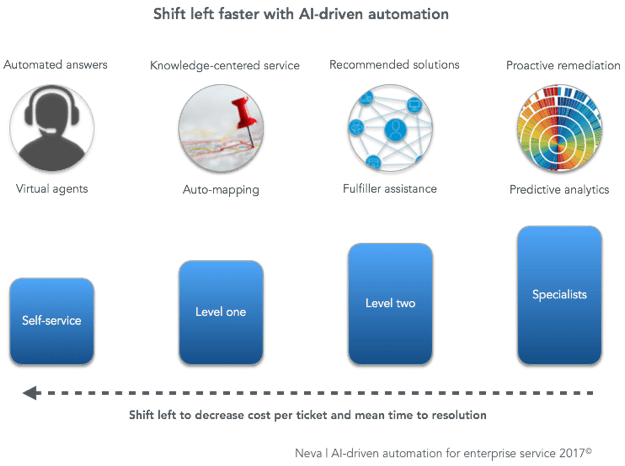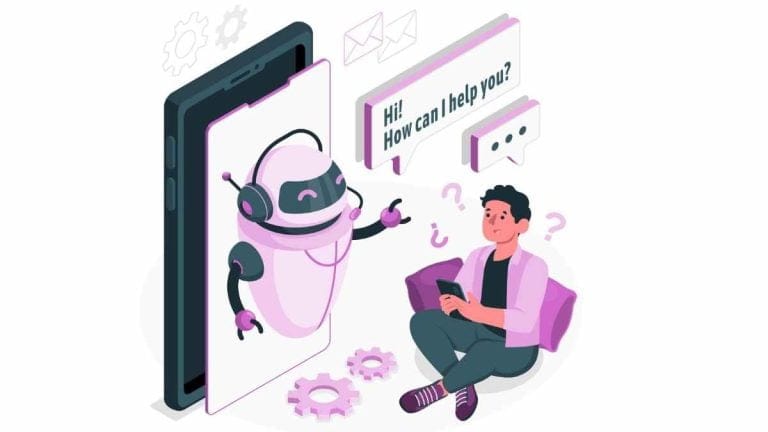How shifting left with AI automation benefits all levels of IT support
Table of Contents
ToggleIn previous Neva blogs (Shift left: empowerment as-a-service and Shift left: empowerment as-a-service part 2 AI-driven automation), I discussed how AI-based automation accelerates the adoption and success of shift-left strategies.
This post outlines the specific tasks associated with each level of IT support and discusses how AI-driven automation improves efficiencies for IT, enabling adoption of modern workplace technologies and delivery of superior service.

Level 1
A level 1 support agent’s primary responsibility is triaging service desk tickets and providing basic support and troubleshooting. Level 1 typically relies on knowledge articles and standard fixes for common issues, such as password resets and application access. Level 1 agents must also collect information regarding the requester’s location, issue type and other supporting documentation and manually enter it into incident records as part of ticket escalation processes.
Benefits of AI-driven shift left for level 1
- Auto-populate useful data (i.e, employee ID, assigned assets, contact information and related incidents) from multiple systems into incident records.
- Gain access to related information commonly reserved for level 2 staff (i.e, CMDB access and app/system configuration details).
- Provide real-time suggestions to requests based on issue type and location, allowing them to quickly resolve issues and order goods and services, via self-service.
AI-driven shift left enables Level 1 to spend less time on repetitive tasks and more time on root cause analysis of issues, helping to minimize escalations, reduce MTTR, and reduce future incidents.
Level 2
Level 2 is commonly responsible for performing break/fix tasks related to desktop hardware and software. This includes responding to issues regarding operating system (OS) configurations, application installations and hardware repair. Level 2 staff typically have specialized knowledge of how specific systems and applications are configured and operated by end users.
Benefits of AI-driven shift left for level 2
- Automatically categorize, prioritize and assign incidents to specific support agents based on the request’s specific issue type, location, etc.
- Enrich incident records with valuable information such as related incidents, configuration items, system changes and known issues/resolutions.
- Gain real-time and predictive insights into incident trends to limit unnecessary downtime and ensure SLAs are maintained.
Shift left allows level 2 to spend less time performing root cause analysis of common issues and focus more on strategic initiatives, such as new OS, device and application deployments.
Level 3
Level 3 staff are involved in the development and engineering of IT systems and services. They deal with complex matters regarding business applications and networking issues. Level 3 tasks commonly include areas such as database, networking and infrastructure administration.
Benefits of AI-driven shift left for level 3
- Gain visibility into incidents and trends regarding service disruptions associated with new systems and service rollouts, non-tested applications and infrastructure failures.
- Surface and correlate IT and business data to optimize systems while reducing the footprint of services experiencing little to no usage.
- Dedicate more time to preventive maintenance, research, and innovation.
Due to the fact that Level 3 agents have the most hands-on technical expertise and are the highest-level of internal support staff, they tend to receive a high number of escalated incidents that, if provided with the appropriate resources, could and should be handled by level 1 or 2. Level 3 resources are the most expensive. AI-driven automation reduces the need for level 3 involvement by empowering level 0 (self-service) through 2 to perform tasks previously reserved for level 3 and higher.
Level 4
Level 4 commonly refers to external IT service providers. This includes vendors that are contracted by IT for specific services such as internet, mobile and cloud services.
Benefits of AI-driven shift left for level 4
Shift left minimizes the time and effort required for expensive level 4 resources to resolve issues. Level 4 technicians are typically dispatched from a remote site, are billed hourly, and charge for travel time. Shift left strategies ensure they’re only deployed when necessary – and when they are, they have intelligent recommendations to help them resolve issues expeditiously on the first visit.
Managers
Managers are responsible for ensuring that workplace technologies are delivering value across the entire organization. Managers must identify ways to improve IT service quality and eliminate expense leaks. To do this effectively, managers must maintain a deep understanding of what the business is trying to accomplish with technology as well as when, where, and how IT services are being consumed.
Benefits of AI-driven shift left for Managers
- Surface operational data in real-time to measure the health of IT services by topic, geography, team and role
- Proactively assess future resource requirements, vendor relationships and budget requirements by correlating and displaying valuable IT and business data.
- Utilize trend analytics insights regarding the adoption of employee self-service, support costs and customer sat scores.
AI-driven automation allows all levels of IT support to more effectively share and access valuable information, allowing them to better align their support functions with the needs and expectations of customers. As a result, IT organizations can move from reactive to proactive posture in terms of delivering and supporting business objectives.






